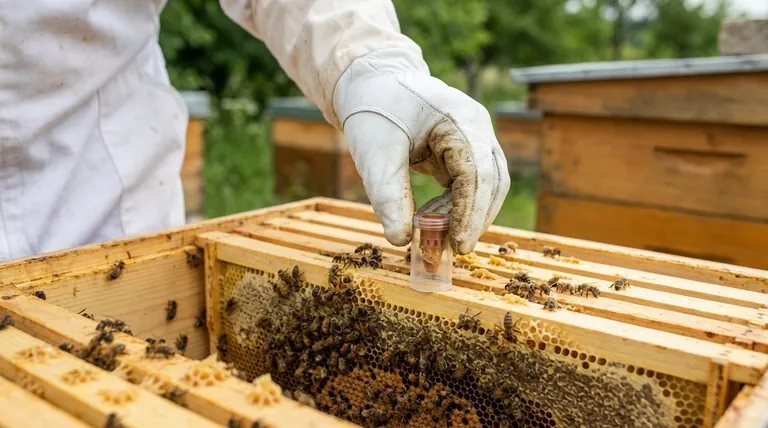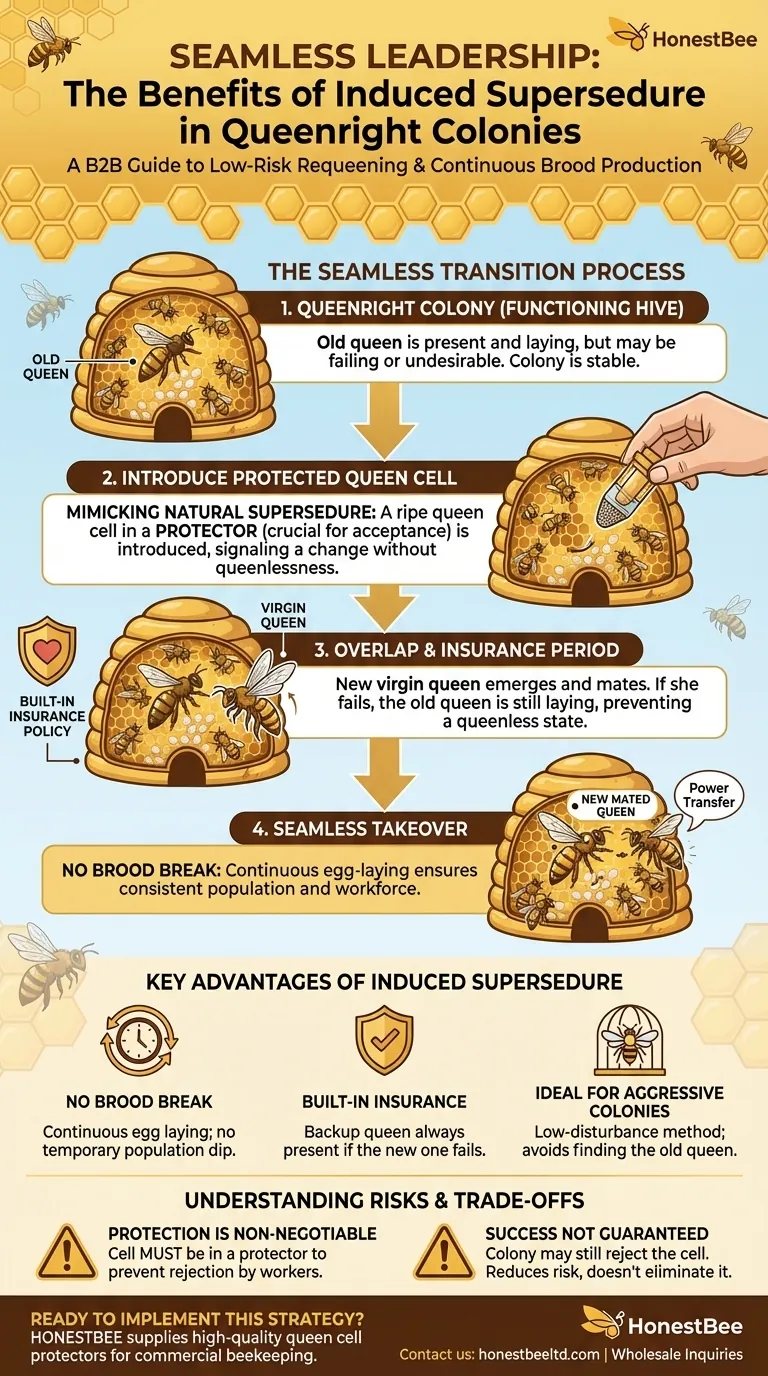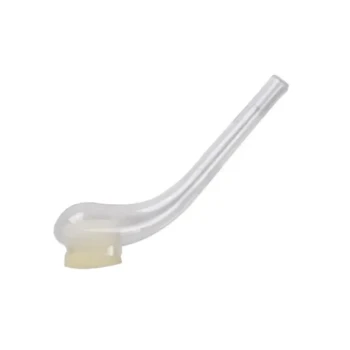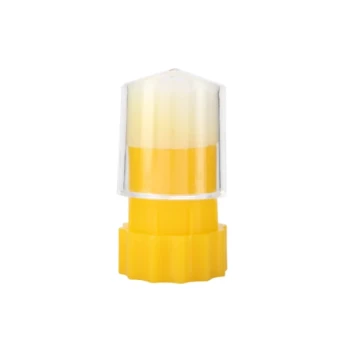The primary benefit of this requeening method is that it provides a seamless transition between queens. It allows a new, vigorous queen to begin her life cycle without the colony ever suffering a "brood break," or a gap in egg-laying, while keeping the original queen as a built-in insurance policy against failure.
This technique leverages the colony's natural supersedure instinct to replace a failing monarch. By introducing a protected cell into a queenright colony, you create a safe overlap where the new virgin queen can emerge and mate before the old queen is eliminated, guaranteeing the colony is never left without a laying queen.

The Core Principle: Mimicking Natural Supersedure
What is Supersedure?
Supersedure is the natural process where a honey bee colony decides to replace its own queen. This typically happens when the queen is old, injured, or her pheromone output and egg-laying rate decline.
The bees will raise a new queen from an existing egg while the old queen continues to lay. Once the new queen emerges, mates, and proves her viability, she replaces the old one, ensuring a smooth transfer of power.
How This Method Hijacks the Process
By introducing a ripe queen cell, you are essentially forcing the colony's hand. You are providing them with a superior replacement queen candidate, signaling that it's time for a change without the panic and disruption of the colony becoming queenless.
The key is that the colony remains queenright (believes it has a functional queen), which keeps its behavior calm and stable throughout the process.
Key Advantages of Induced Supersedure
Eliminates the Brood Break
In many requeening methods, the beekeeper removes the old queen, creating a period of 3-4 weeks with no new eggs being laid. This results in a temporary dip in the colony's population and workforce.
With induced supersedure, the old queen continues to lay eggs right up until the new, mated queen is ready to take over. This ensures a continuous cycle of brood and a consistently strong population.
Provides a Built-in Insurance Policy
The greatest risk in requeening is the failure of the new queen. She could be lost on her mating flight, fail to mate properly, or be rejected by the colony.
This method mitigates that risk entirely. If the new virgin queen fails for any reason, the old queen is still present and laying eggs. The colony is not left in a hopeless, queenless state.
Ideal for Requeening Aggressive Colonies
Finding and removing a queen from a "hot" or aggressive hive is one of the most challenging tasks in beekeeping. It often results in significant disruption and a large number of stings.
This method is exceptionally low-disturbance. You simply place the protected queen cell in the hive and walk away, letting the bees manage the transition on their own.
Understanding the Trade-offs and Risks
The "Protection" is Non-Negotiable
You cannot simply place a bare queen cell in a queenright hive. The workers, loyal to their current queen, will almost certainly identify it as a foreign rival and destroy it.
The cell must be in a queen cell protector (a small plastic cage or a wrap of aluminum foil). This prevents the bees from chewing through the side of the cell, while leaving the tip exposed for the queen to emerge.
The Two-Queen Window is Temporary
While both queens may exist in the hive for a short period, this is not a permanent state. Once the new queen has successfully mated and begun laying, the bees will typically dispatch the old queen.
Success Is Not Guaranteed
While this method has a high success rate, it is not foolproof. The colony may still decide to reject the cell, or the old queen's pheromones may be strong enough to convince the workers to destroy it upon emergence. It reduces risk, but does not eliminate it.
Making the Right Choice for Your Colony
Is this the right requeening method for your goal? Consider your primary objective.
- If your primary focus is improving genetics with minimal risk: This method is ideal because it prevents a brood break and provides a backup queen in case of failure.
- If your primary focus is requeening an aggressive colony: This is one of the best low-disturbance techniques available, as you don't need to find and remove the old queen.
- If your primary focus is speed and certainty: Introducing a new, mated queen you have purchased may be faster, though it carries a higher risk of rejection and requires you to find the old queen.
By understanding how to work with the bees' natural instincts, you can guide your colony through a seamless leadership transition, ensuring its continued health and productivity.
Summary Table:
| Advantage | Description |
|---|---|
| No Brood Break | Old queen continues laying until new queen is ready, ensuring a strong, continuous workforce. |
| Built-in Insurance | If the new queen fails, the original queen remains, preventing a queenless colony. |
| Low-Disturbance | Ideal for aggressive hives; no need to find and remove the old queen, minimizing stings and stress. |
Ready to implement this low-risk requeening strategy in your apiary? HONESTBEE supplies commercial beekeepers and equipment distributors with the high-quality, durable supplies needed for success—including queen cell protectors essential for this method. Let our wholesale-focused operations support your productivity and profitability.
Contact our expert team today to discuss your beekeeping supply needs!
Visual Guide

Related Products
- Brown Nicot Queen Cell Cups for Breeding Queen Bees Beekeeping
- JZBZ Type Wide Base Plastic Queen Cell Cups for Base Mounting and Queen Rearing
- JZBZ Push-In Queen Cell Cups for Beekeeping
- JZBZ Langstroth Queen Rearing Frame for Beekeeping
- Clear Black Plain Polystyrene Queen Bee Grafting Cell Cups No Lug for Bee Queen Cup
People Also Ask
- How does Queen Rearing with JZBZ work? A Reliable System for Consistent Queen Production
- What are the ideal conditions for raising good queen cells? Achieve Robust Queens with Strong Cell-Builder Colonies
- Why is it important to select a healthy larva less than 24 hours old for queen rearing? Maximize Queen Quality and Colony Strength
- What are the signs that a queen cell is about to emerge? Master the Critical Timing for Hive Success
- What is the advantage of the Nicot Cupkit system? Secure Your Queen Rearing Success with Batch Protection



















